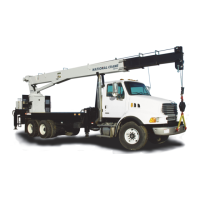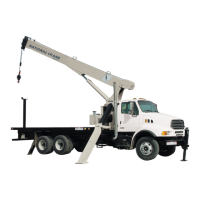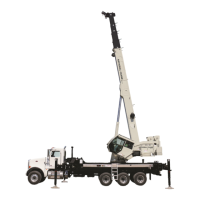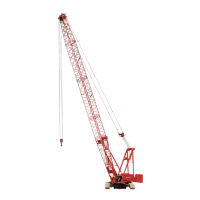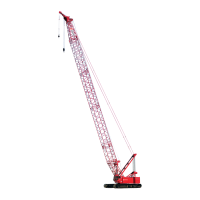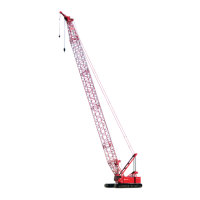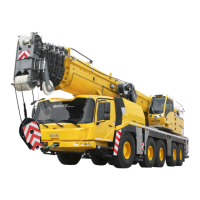OPERATING CONTROLS 1400H OPERATOR AND SERVICE MANUAL
2-12 Published 10-30-2014 Control # 040-09
If the light and audible alarm do not function as
described and the crane movements are not stopped,
the system is not working properly.
• If the crane is equipped with a boom extension that
is deployed and rigged for work, repeat the test
procedure for the boom extension anti-two-block switch.
• Check that the display of the main boom length
agrees with the actual boom length.
• Check that the display of the main boom angle
agrees with the actual boom angles.
• Check that the display of the operating radius of the
crane agrees with the actual radius.
• Check the load display by lifting a load of known
weight. The accuracy of the load indication shall be
within the tolerance of SAE J159.
Operation
After being properly checked, the RCL is operational.
The operator shall be thoroughly familiar with all controls of
the RCL and he shall properly set the reeving input before
operating the crane. The proper function of the system shall
be checked by lifting a load of known weight and comparing
the load to the information displayed on the RCL.
Rated loads include the weight of the hook block, slings,
and auxiliary load handling devices. Their combined weights
shall be subtracted from the listed load capacities as stated
on the load capacity chart to obtain the net load to be lifted.
If any of the displays reflect a deviation between
displayed and actual values, an authorized PAT service
representative shall be called for repair of the system or
reverification of the crane's RCL calibration.
Any structural modifications or changes to the
crane shall require reverification of the crane's RCL
calibration.
The RCL will warn the operator when hoist and
loadline overload occurs but will allow the boom up
function to continue to operate. Booming up a hoist and
loadline overload in areas where the boom capacity
exceeds the loadline capacity can cause serious
damage to the hoist and loadline. Always reeve the
loadline properly for the load to be lifted.
Work Site Position
Always seek the best possible work site when parking
the crane. An ideal parking location at a job site is firm, level,
dry ground or pavement located in close proximity to the
work station. Avoid uneven, rocky or muddy terrain, steep
grades or locations with unnecessary overhead obstructions.
Location should be selected such that outriggers can be fully
extended and leg comes down on firm level surface.
Particular care must be taken in selecting a site position to
the location of overhead power lines so that proper
clearance conditions can be maintained. Ideally, one should
select a location at which the boom could not come within
minimum recommended distance of the power lines at full
extension.
It is best to select a location on the site such that most of
the lifting can be done over the outrigger support or rear of
the truck.
Before Leaving the Cab
1. Position the truck so that the outriggers can be extended
without encountering obstructions. Set the truck park
brake securely. Wheel chocks may be required under
certain conditions.
2. Engage PTO by using one of the methods outlined
earlier in Truck Cab Controls section.
3. Bring the hydraulic system up to operating temperature
(oil reservoir warm to the touch) by allowing the system
to operate with all controls in neutral.
Crane Set Up
Do not operate the boom until all outriggers are
extended and set providing firm support.
If operating on sloping ground provide blocks. When
lifting is to be done on soft terrain or hot asphalt, support the
outrigger and stabilizer pads with bearing pads. Some
concrete and asphalt surfaces are relatively thin and cannot
support outrigger or stabilizer loading. Concrete can break
through and cause instability.
DANGER
!
DANGER
!
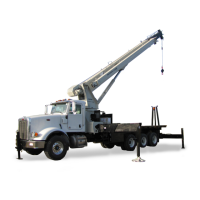
